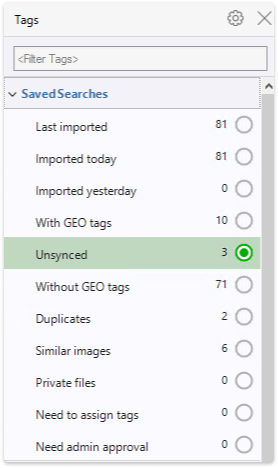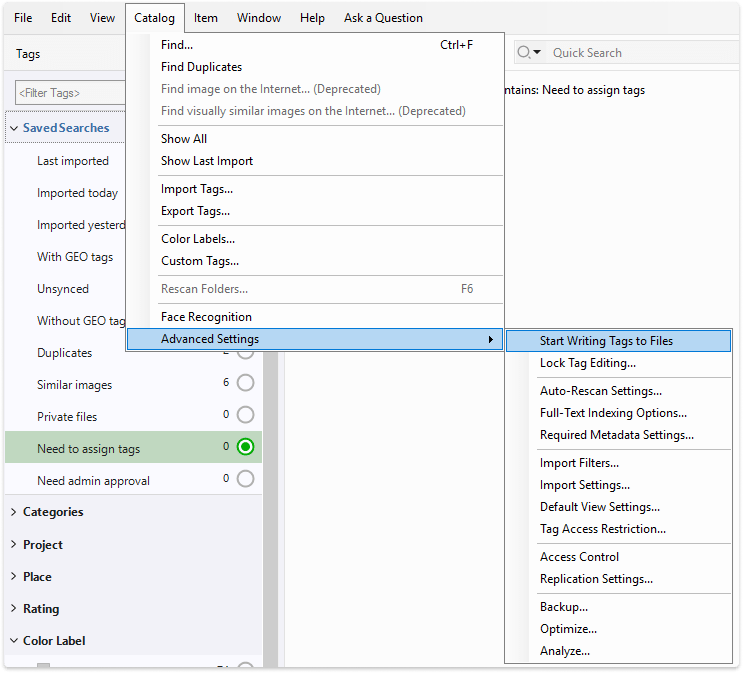By default, all tags assigned to your files into Daminion are stored only in the catalog. However, Daminion also allows you to write these tags directly to the metadata in the original files, which gives your data an additional level of security: all descriptive information is stored not only in the Daminion database, but also in your original files.
The ability to define where you want to store your data also means you are not bound by a proprietary system and can migrate to another system at any time: all the tags assigned in Daminion will travel with the original files.
For file formats that support IPTC/XMP metadata standards (for example, JPEG or MP3), Daminion embeds the tags directly into the file’s metadata. For other file formats that don’t natively support IPTC/XMP metadata, Daminion creates an XMP sidecar file with the same name and saves it in the same folder as the original. Metadata storage rules for files that don’t support metadata embedding can be set up in Daminion Server Preferences. For more information, refer to Daminion Server Metadata Preferences.
![]() Important Info about Daminion’s automatic synchronization of tags to file metadata.
Important Info about Daminion’s automatic synchronization of tags to file metadata.
Please read this before enabling this option!
- By default, automatic synchronization is turned off in Daminion.
- When you assign, edit, or remove tags, Daminion saves this information in its database catalog only (to avoid blocking the operation of the Daminion Server).
- Once the automatic synchronization option is activated, all changes previously made to tags, as well as any tag changes you make from now on, will be placed into the synchronization queue in the background.
- Even if you turn automatic synchronization on, all tag changes are not immediately embedded into file metadata.
- The speed of embedding tags into metadata depends on various factors and can be slow. Daminion Server requires time to process the queue of files marked for modification, as well as files that were previously added to the queue.
- Additionally, the time interval between file changes in Daminion Server and their embedding into files can be significantly longer for certain file formats and files stored on network devices (such as NAS or remote file storage).
- Depending on the number of files with changed tags, this process can result in increased network load. Therefore, it is usually not recommended to keep auto-synchronization constantly on. Instead, activate it once a day when no one is working with the catalog and turn it off when the changes are synchronized.
It is critically important to understand that if users have direct access to files stored on the Daminion Server and move these files outside of Daminion Server, any tags not yet embedded in the metadata will remain stored only in the catalog.
If a user moves a file before Daminion Server has had the chance to process it, Daminion will not be able to write this data into the file’s metadata because the file has been relocated.
This also applies to copies of such files. To write tags from the Daminion Server catalog into the metadata of these files, you must provide Daminion with valid links to the relocated files by using the Relink File or Relink Folder functions.
Therefore, it is strongly recommended to perform all file operations through the Daminion interface to reduce server load and avoid such issues.
Checking the number of unsynchronized items
Before you turn auto-synchronization on, you may want to find out how many items in your catalog are not synchronized. If you started with a fresh catalog, but have already assigned several tags to certain items, the number of synced and unsynced items will be different. In this case, items with no tags assigned in Daminion will be shown as synchronized; conversely, items with edited tags will be shown as unsynchronized.
Synchronization status can be checked on the Tags panel under the Saved searches tab. If Saved Searches is not displayed in your catalog, click the little gear icon on the Tags panel header bar, select Customize and then check Saved Searches. Under the Saved Searches tab, check the Unsynced tag. If you want to view all unsynced items in the Browser window, click the little empty circle to the right of Unsynced.

Start Auto-Synchronization
Go to Catalog > Advanced Settings > Start Writing Tags to Files

After selecting the menu, a notice will appear, which you should read carefully and confirm your consent by activating the checkbox and confirming by pressing the OK button.

Daminion starts to synchronize all assigned tags with file metadata.
Stop Auto-Synchronization
To stop the sync process, go to Catalog > Advanced Settings > Stop Writing Tags to Files
Auto-Synchronization is a one-sided process that synchronizes database records (tags) with file metadata only. If you want to synchronize metadata changes made in external applications with Daminion database, please refer to Automatic Folder Rescan.